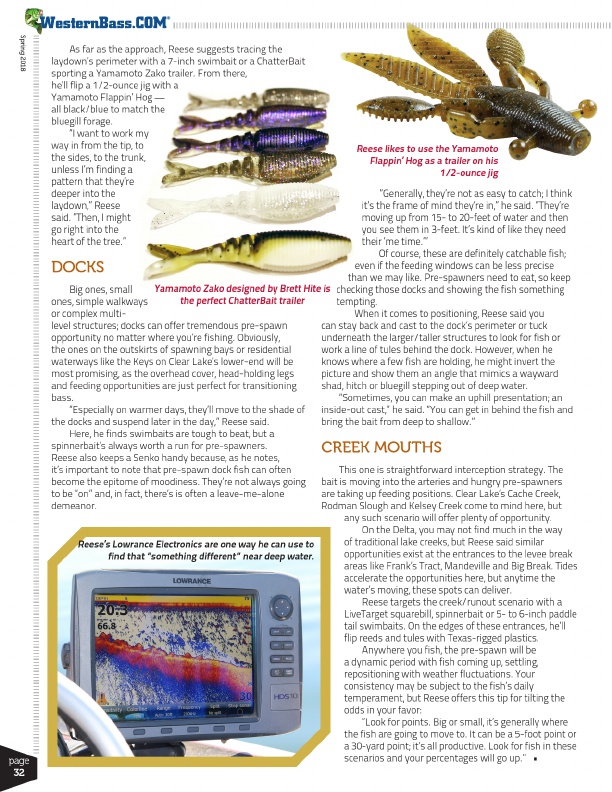
®
Spring 2018
page
32
As far as the approach, Reese suggests tracing the
laydown’s perimeter with a 7-inch swimbait or a ChatterBait
sporting a Yamamoto Zako trailer. From there,
he’ll flip a 1/2-ounce jig with a
Yamamoto Flappin’ Hog —
all black/blue to match the
bluegill forage.
“I want to work my
way in from the tip, to the sides, to the trunk, unless I’m finding a pattern that they’re
Reese likes to use the Yamamoto
Flappin’ Hog as a trailer on his
1/2-ounce jig
deeper into the
“Generally, they’re not as easy to catch; I think
laydown,” Reese
it’s the frame of mind they’re in,” he said. “They’re
said. “Then, I might
moving up from 15- to 20-feet of water and then
go right into the
you see them in 3-feet. It’s kind of like they need
heart of the tree.”
their ‘me time.’”
Of course, these are definitely catchable fish;
DOCKS
even if the feeding windows can be less precise than we may like. Pre-spawners need to eat, so keep
Big ones, small Yamamoto Zako designed by Brett Hite is checking those docks and showing the fish something
ones, simple walkways
the perfect ChatterBait trailer
tempting.
or complex multi-
When it comes to positioning, Reese said you
level structures; docks can offer tremendous pre-spawn
can stay back and cast to the dock’s perimeter or tuck
opportunity no matter where you’re fishing. Obviously,
underneath the larger/taller structures to look for fish or
the ones on the outskirts of spawning bays or residential
work a line of tules behind the dock. However, when he
waterways like the Keys on Clear Lake’s lower-end will be
knows where a few fish are holding, he might invert the
most promising, as the overhead cover, head-holding legs
picture and show them an angle that mimics a wayward
and feeding opportunities are just perfect for transitioning
shad, hitch or bluegill stepping out of deep water.
bass.
“Sometimes, you can make an uphill presentation; an
“Especially on warmer days, they’ll move to the shade of inside-out cast,” he said. “You can get in behind the fish and
the docks and suspend later in the day,” Reese said.
bring the bait from deep to shallow.”
Here, he finds swimbaits are tough to beat, but a
spinnerbait’s always worth a run for pre-spawners. Reese also keeps a Senko handy because, as he notes,
CREEK MOUTHS
it’s important to note that pre-spawn dock fish can often
This one is straightforward interception strategy. The
become the epitome of moodiness. They’re not always going bait is moving into the arteries and hungry pre-spawners
to be “on” and, in fact, there’s is often a leave-me-alone
are taking up feeding positions. Clear Lake’s Cache Creek,
demeanor.
Rodman Slough and Kelsey Creek come to mind here, but
any such scenario will offer plenty of opportunity.
On the Delta, you may not find much in the way
Reese’s Lowrance Electronics are one way he can use to
find that “something different” near deep water.
of traditional lake creeks, but Reese said similar opportunities exist at the entrances to the levee break areas like Frank’s Tract, Mandeville and Big Break. Tides
accelerate the opportunities here, but anytime the
water’s moving, these spots can deliver.
Reese targets the creek/runout scenario with a
LiveTarget squarebill, spinnerbait or 5- to 6-inch paddle
tail swimbaits. On the edges of these entrances, he’ll
flip reeds and tules with Texas-rigged plastics.
Anywhere you fish, the pre-spawn will be
a dynamic period with fish coming up, settling,
repositioning with weather fluctuations. Your
consistency may be subject to the fish’s daily
temperament, but Reese offers this tip for tilting the
odds in your favor:
“Look for points. Big or small, it’s generally where
the fish are going to move to. It can be a 5-foot point or
a 30-yard point; it’s all productive. Look for fish in these
scenarios and your percentages will go up.” •